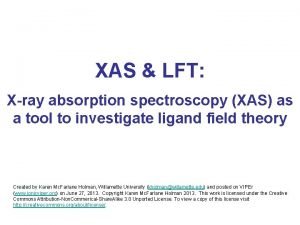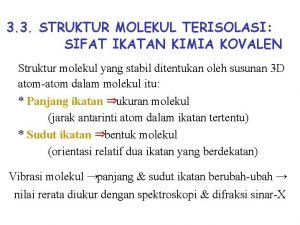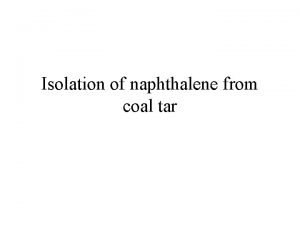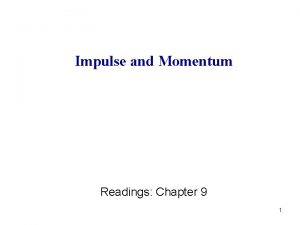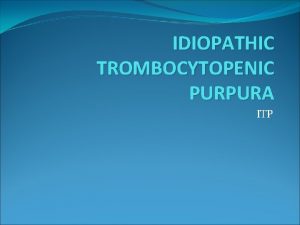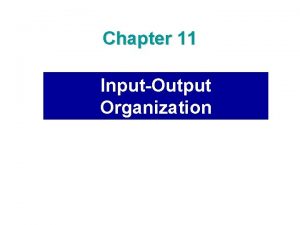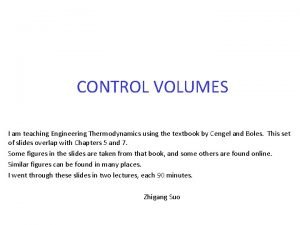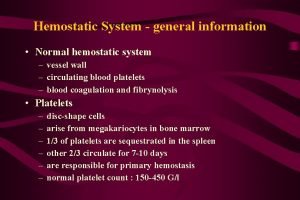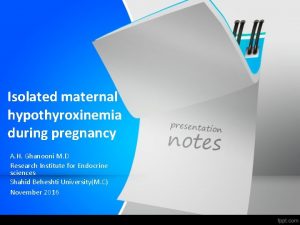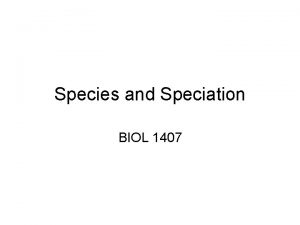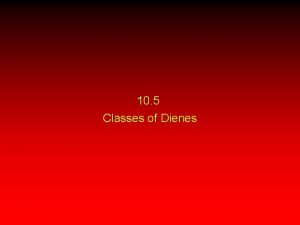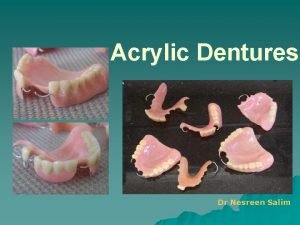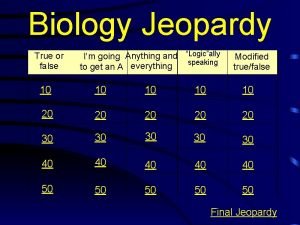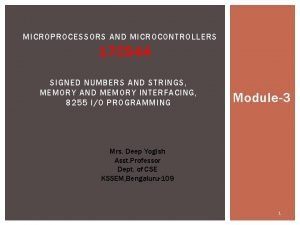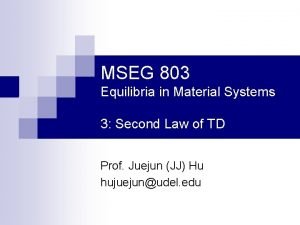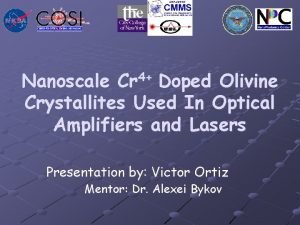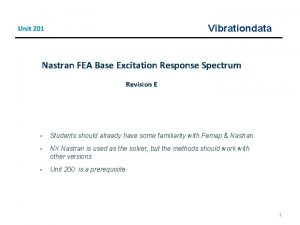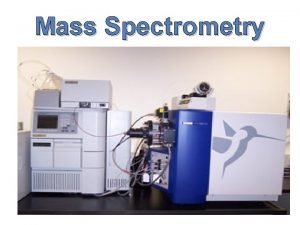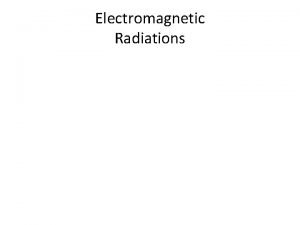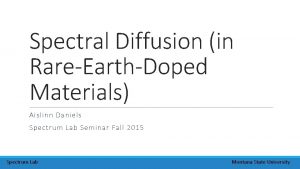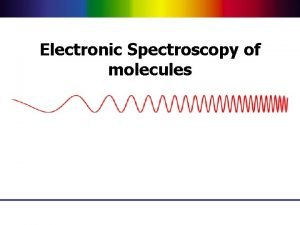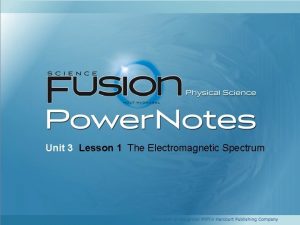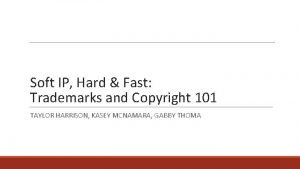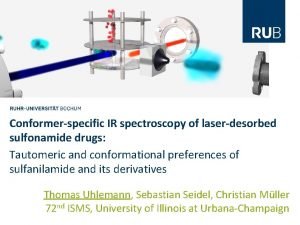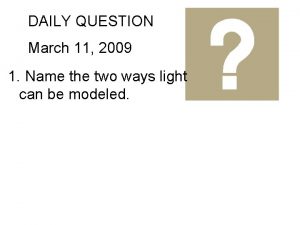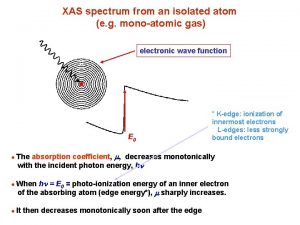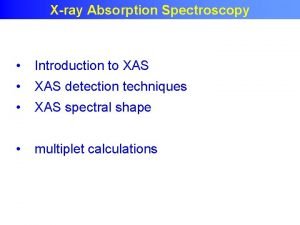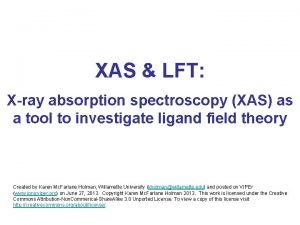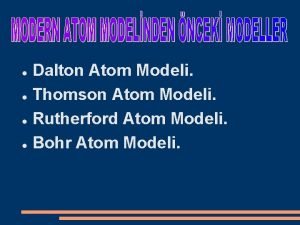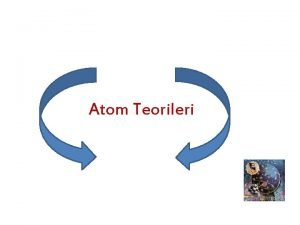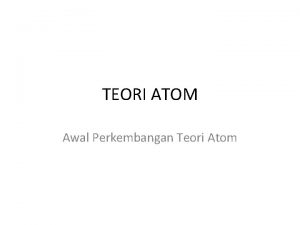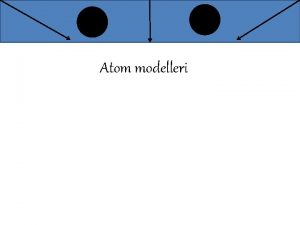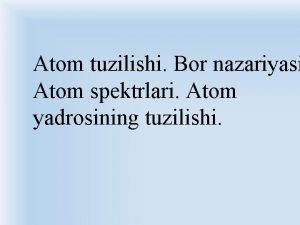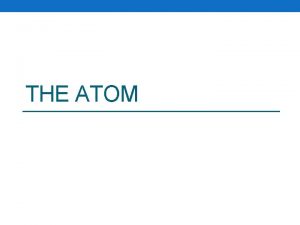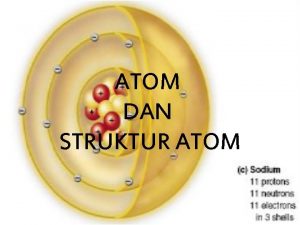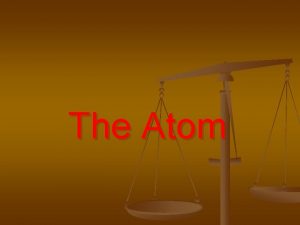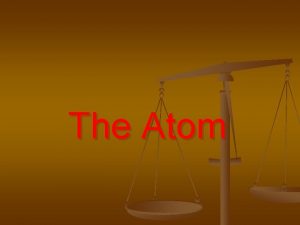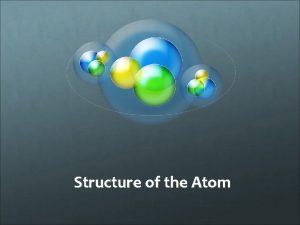XAS spectrum from an isolated atom e g



























![B - Initial 2 x [Cu(+2) HG(-)G] configuration [Cu(+2)]1 Cu(+2) [HG(-)G]1 O N [Cu(+2)]2 B - Initial 2 x [Cu(+2) HG(-)G] configuration [Cu(+2)]1 Cu(+2) [HG(-)G]1 O N [Cu(+2)]2](https://slidetodoc.com/presentation_image_h/21fc5760d21f3161fff46e12c79a7785/image-28.jpg)
















- Slides: 44

XAS spectrum from an isolated atom (e. g. mono-atomic gas) electronic wave function E 0 * K-edge: ionization of innermost electrons L-edges: less strongly bound electrons absorption coefficient, m, decreases monotonically with the incident photon energy, hn ● The hn = E 0 = photo-ionization energy of an inner electron of the absorbing atom (edge energy*), m sharply increases. ● When ● It then decreases monotonically soon after the edge

XAS spectrum from a non-isolated atom (e. g. a diatomic molecule ) electronic wave function interference absorption coefficient, m a multi-atomic system m doesn’t decrease monotonically after the edge, rather it has an oscillating behaviour ● In ● The absorber (red dot) emits an outgoing spherical wave (the ionized electron, photo-electron) ● The scatterer (green dot) acts as diffusion center of the backscattered wave, which interferes (in phase or out-of-phase) with the outgoing wave

EXAFS analysis of Cu++ site geometry in Prion peptide complexes (EMBL-DESY) Hamburg S 1. (Bo. Pr. P 25 -30, 60 -70) KKRPKPWGQPHGGGWGQ S 2. (Bo. Pr. P 25 -30, 60 -78) KKRPKPWGQPHGGGWGQ S 3. (Bo. Pr. P 25 -30, 60 -94) KKRPKPWGQPHGGGWGQPHGGGWGQ S 4. (a. Bo. Pr. P 24 -242) CKKRPKPGGGWNTGGSRYPGQGSPGGNRYPPQGGGGWGQPHGGGWGQPHGGGWGQPHGGGGWGQGGTHGQWNKPSKPKTNMKHVAGAAAAG AVVGGLGGYMLGSAMSRPLIHFGSDYEDRYYRENMHRYPNQVYYRPVDQYSNQNNFVHDCVNITV KEHTVTTTTKGENFTETDIKMMERVVEQMCITQYQRESQAYYQRGAS Cu++ stoichiometry Sample N Cu++ equivalence E E/N S 1 1 0. 5 S 2 2 1. 5 0. 75 S 3 a S 3 b 4 4 3. 2 2. 0 0. 8 0. 5 S 4 4 -5 2. 0 0. 5/0. 4 N: number of Cu++ coordination sites in the complex = number of octarepeats E: [Cu++] / [protein (or peptide)] E/N: number of sites saturated with Cu++ = [Cu++] / [octarepeat] sub-stoichiometric Cu++ concentration Morante et al. , J. Biol. Chem. 279 (2004) 11753

EXAFS data: Single and Multiple Scattering contributions Fitted curves are within data fluctuations S 1 S 4 His’s are identified from their typical MS contributions S 1 S 2 S 3 S 4

Model interpretation of EXAFS data analysis 1 His PHGGGWGQ Intra-octarepeat PHGGGWGQ M 2 Increasing Cu concentration Cu : octarepeat = 1: 1 M 1 M 2 Cu : octarepeat = 1: 2 2 His PHGGGWGQ Inter-octarepeat In the actual experimental situation no aggregates form

Extracting structural information from EXAFS data Data are expressed analyzed in terms of absorption coefficient absorption cross section Fermi’s golden rule photon frequency density of photo-electron final state polarization vector of incidente radiation matrix element describing the electron transition |i > : initial bound state |f > : final “free” state

Initial, |i>, and the final states, |f>, are eigenfunctions of the Hamiltonian The potential is (most often) evaluated in the so-called muffin tin (MT) approximation The MT potential consists of non overlapping spherical regions In the interstitial regions the potential is set to a constant

Computing the transition matrix element, q Electron initial state: one neglects V The Schrödinger equation for the innermost (K) electron is whose normalized solution is n=1, l=0 eigenfunction of hydrogen atom q Electron final state: one neglects the Coulomb potential The Schrödinger equation for the outgoing electron is H 0 is the free Hamiltonian, V is the potential due to the presence of scatterers

Iterative solution: let’s write wave function of a free electron of momentum and satisfies the equation we have inserting the definition of Introducing the Green function where, we recall

one obtains ● Stopping the expansion after the first term (single scattering events), one gets atomic absorption contribution (isolated atom) oscillations of the EXAFS signal ● Including further terms (multiple scattering events), one gets s s hn A s s

In Single Scattering approximation ( ) Boland Crane Baldeschwieler, JPC 77, 142 (1982) N 3= 8 Ni, Ri, si are fit parameters R 1

Single scattering approximation Information on type, number and mean distance of scatteres BUT |f(k, p)| Copper ligands in the Prion peptide nitrogen oxigen Need Multiple Scattering terms in sa to disentangle C, O and N contributions k (Å)-1 Light atoms: C, O and N

Need to know ● the position of atoms in the vicinity of Cu, as the whole analysis of EXAFS data rests on this knowledge ● which are the actual metal ligands ● how the rest of the peptide is structurally organized Ab initio calculations are necessary ● Quantum Mechanics to determine the atomic force field (in the Born-Oppenheimer approximation) ● Electrons are dealt with by DFT (Density Functional Theory) - Schroedinger equation is solved à la Kohn-Sham ● Atoms are treated classically ● Car-Parrinello simulations especially useful - Atomic Molecular Dynamics - Some dynamics helps in understanding stability

The DFT method STEP 1 Decoupling of atomic and electronic dof’s (n. A’s << nel’s BOA) STEP 2 At fixed atomic coordinates, compute the electronic ground-state w. f. with the help of DFT (Schroedinger eq Kohn-Sham eq’s) STEP 3 “Optimize” atomic coordinates to adapt them to the currently computed inter-atomic potential STEP 4 Iterate STEP 2 and STEP 3 until you get consistency The Car-Parrinello idea Update atomic coordinates while solving Kohn-Sham eq’s Faster convergence CPU-time Control over configuration stability Atomic and KS eq’s are made to both look Newtonian (2 nd order in time)

In Formulae Starting point is the Schroedinger equation electronic coordinates atomic coordinates

STEP 1 BO Molecular Dynamics Atoms move classically in the Quantum Mechanical potential generated by the electrons living in their ground-state w. f. , Y 0 Difficulties Schroedinger eq. should be solved over and over again at each atomic MD step Contributions of excited states should be taken into account One does not really know how to solve the electronic Schroedinger eq.

A useful approximation is Hartree-Fock ● Y 0 is written as a Slater determinant (Pauli principle) of Ne single particle trial w. f. ’s, {yi(ri)} ● The latter are determined by minimizing the total electronic energy ● He. HF is a one-body Hamiltonian ● which depends non-locally and non-linearly on all {y}

STEP 2 DFT provides a way to systematically map the many-body problem (with electron self-interaction, W) into a single-body problem (without electron self-interaction, W) DFT is based on the Hohenberg-Kohn (Phys. Rev 136 (1964) 864) Theorem “There exists a one-to-one mapping between the set of UA potentials and the set of (admissible) ground-state electronic densities” Lemma 1 Since UA fixes He Y 0 is in turn a unique functional of n, hence of UA HK mapping

Lemma 2 is a well-defined, universal functional of the (admissible) electronic density Lemma 3 The functional 1) attains its minimum when , i. e. when the electronic density equals the value which is in correspondence with UA in the HK mapping 2) at the minimum it equals the total electronic energy Corollary We can compute the ground-state electronic density, hence all the ground-state observables, from the minimum equation ( ) except that we do not know the HK-functional, FHK Kohn and Sham have proposed a way to go around this problem

The Kohn-Sham equations ◘ The key observation is that the HK mapping exists, even if we set the electronic self-interaction term to zero in all the above equations, W ≡ 0 - in this situation the many-body electronic Schroedinger equation separates into N decoupled one-body equations - furthermore for any given electronic density, n, there exists a u. ANSI such that one can represent n as the sum of the moduli square of the solutions of the one-body Schroedinger equation Kohn-Sham equations

◘ We are done if we can find the relation between u. A and u. ANSI - Y 0 is exactly the Slater determinant of the { i} - the NSI HK-functional is simply the kinetic energy - and satisfies the equation ( ) ◘ We now rewrite ◘ Minimizing in the form and using equations ( ) and ( ), we get

◘ Inserting back u. ANSI in the KS equations one ends up with ( ) - formally identical to the HF equations, but for - ei are Lagrange multipliers enforcing < i | j > = dij ◘ On the solution the total energy reads - it is a function of the atomic positions - it plays the role of inter-atomic potential in MD simulations ◘ We need an expression for - for the Free Electron Gas - LDA / GGA / … and

STEP 3 STEP 4 “Optimization” of atomic coordinates can be achieved in various ways 1) Solve the classical eqs of motion but, need to know EHK[{R}] for all values of {R} 2) Solve simultaneously classical eqs of motion for atoms and the KS eqs for electrons Car-Parrinello It can be elegantly done by introducing the effective Lagrangian {R} and { } are Lagrangian coordinates, n(r) = Si i*(r) i(r) and

- Rather than the minimum equation ( ), we get for the electronic w. f. , the 2 nd order equation in the (fictitious) time ei eigenvalues of Lij 0= - A unique time step for atomic MD and KS eqs, Dt ≈ femtosecond - We need to solve the KS eqs by adiabatically lowering the electronic “kinetic energy” ● “total electronic energy” is (almost) conserved we have a Lagrangian system little energy transfer between atoms and electrons ● by progressively lowering Te 0, the system will end in the minimum of the “potential” ● where the force, hence the acceleration is zero

CP dynamics is implemented in a number of codes, among which Quantum ESPRESSO and CPMD http: //www. quantum-espresso. org/ ● ● Quantum ESPRESSO is an initiative of the DEMOCRITOS National Simulation Center (Trieste) and of its partners. In collaboration with – – – ● CINECA, the Italian National Supercomputing Center in Bologna Ecole Polytechnique Fédérale de Lausanne Princeton University Massachusetts Institute of Technology Many other individuals… Integrated computer code suite for electronic structure calculations and materials modeling at the nanoscale – – – ● http: //www. cpmd. org/ Released under a free license (GNU GPL) Written in Fortran 90, with a modern approach Efficient, Parallelized (MPI), Portable Suite components – PWscf (Trieste, Lausanne, Pisa): self-consistent electronic structure, structural relaxation, BO molecular dynamics, linear-response (phonons, dielectric properties)

The Quantum-ESPRESSO Software Distribution ● Car-Parrinello variable-cell molecular dynamics with Ultrasoft PP’s. ● Developed by A. Pasquarello, K. Laasonen, A. Trave, R. Car, N. Marzari, P. Giannozzi, C. Cavazzoni, G. Ballabio, S. Scandolo, G. Chiarotti, P. Focher. ● Verlet dynamics with mass preconditioning ● Temperature control: Nosé thermostat for both electrons and ions, velocity rescaling ● Variable-cell (Parrinello-Rahman) dynamics ● Damped dynamics minimization for electronic and ionic minimization ● Modified kinetic functional for constant-pressure calculations ● “Grid Box” for fast treatment of augmentation terms in Ultrasoft PP’s ● Metallic systems: variable-occupancy dynamics ● Nudged Elastic Band (NEB) for energy barriers and reaction paths

A first principle study of the Cu-HGGG interactions A - the monomer B - the dimer Furlan, La Penna, Guerrieri, Morante, GCR, JBIC 12(4) (2007) 571 A - Initial Cu(+2) HG(-)G configuration Cu(+2) O N C H
![B Initial 2 x Cu2 HGG configuration Cu21 Cu2 HGG1 O N Cu22 B - Initial 2 x [Cu(+2) HG(-)G] configuration [Cu(+2)]1 Cu(+2) [HG(-)G]1 O N [Cu(+2)]2](https://slidetodoc.com/presentation_image_h/21fc5760d21f3161fff46e12c79a7785/image-28.jpg)
B - Initial 2 x [Cu(+2) HG(-)G] configuration [Cu(+2)]1 Cu(+2) [HG(-)G]1 O N [Cu(+2)]2 C H [HG(-)G]2 V = (15 A)3

1. 8 ps trajectory @ 300 K Cu bonds with Gly and His are dynamically formed and destroyed no Cu no binding Cu O N C Quantum Mechanics at work Car-Parrinello ab initio simulations

A first principle study of the influence of p. H on the geometry of the Cu binding site in the HGGG + H(Im) peptide Furlan, La Penna, Guerrieri, Morante, GCR, JBIC

System 1, S 1: Cu 2+(His. G 1−G 2−G 3) + Im + 83 (H 2 O) System 2, S 2: Cu 2+(His. G 1 G 2−G 3) + Im + 105 (H 2 O) System 3, S 3: Cu 2+(His. G 1−G 2 G 3) + Im + 92 (H 2 O) System 4, S 4: Cu 2+(His. G 1 G 2 G 3) H PH PH PIm H 1 2 Im 1 PIm + 92 (H 2 O) P: both Gly 1 and Gly 2 deprotonated PH Gly 2: only 2 protonated H PH : both H 1 P: Gly 1 protonated 1 only 2 1 and Gly 2 protonated

S 1: His. G 1 -G 2 -G 3 + Im Nd of isolated imidazole N(Im) N(His) Nd of His N(His) N of first Gly N(G 1) N of second Gly N(G 2) Carbonil O of second Gly O(G 2) N(Im) N(G 1) O(G 2) Atom N(G 2) <d> (Å) s (Å) 2. 07 0. 08 line of N(Im) “coordination sphere” N(His) 2. 10 0. 10 N(G 1) 2. 01 0. 08 N(G 2) 2. 01 0. 08 O(G 2) 3. 80 0. 30

S 2: His. G 1 G 2 -G 3 + Im Nd of isolated imidazole N(Im) N(His) Nd of His N(His) N of first Gly N(G 1) N of second Gly N(G 2) Carbonil O of second Gly O(G 2) N(Im) N(G 1) O(G 2) N(G 2) Atom <d>(Å) s (Å) N(Im) 2. 20 0. 20 N(His) 2. 00 0. 10 N(G 1) 3. 00 0. 40 N(G 2) 1. 96 0. 07 O(G 2) 2. 20 0. 10

S 3: His. G 1 -G 2 G 3 + Im Nd of isolated imidazole N(Im) N(His) Nd of His N(His) N of first Gly N(G 1) N of second Gly N(G 2) Carbonil O of second Gly O(G 2) N(Im) N(G 1) O(G 2) N(G 2) Atom <d>(Å) s (Å) N(Im) 2. 01 0. 07 N(His) 1. 99 0. 07 N(G 1) 2. 00 0. 10 N(G 2) 4. 10 0. 30 O(G 2) 4. 70 0. 40

S 4: His. G 1 G 2 G 3 + Im Nd of isolated imidazole N(Im) N(His) Nd of His N(His) N of first Gly N(G 1) N of second Gly N(G 2) Carbonil O of second Gly O(G 2) N(Im) N(G 1) N(G 2) O(G 2) Atom <d> (Å) s (Å) N(Im) 1. 95 0. 08 N(His) 1. 95 0. 08 N(G 1) --- N(G 2) --- O(G 2) ---

Gly 2 protonated low coordination number BUT. . . Atom 3 N 2 N S 1 S 2 S 3 S 4 His. G 1 -G 2 -G 3 His. G 1 -G 2 G 3 His. G 1 G 2 G 3 <d> s N(Im) 2. 07 0. 08 2. 20 0. 20 2. 01 0. 07 1. 95 0. 08 N(His) 2. 10 0. 10 2. 00 0. 10 1. 99 0. 07 1. 95 0. 08 N(G 1) 2. 01 0. 08 3. 00 0. 40 2. 00 0. 10 --- N(G 2) 2. 01 0. 08 1. 96 0. 07 4. 10 0. 30 --- O(G 2) 3. 80 0. 30 2. 20 0. 10 4. 70 0. 40 --- 3 N 1 OImidazole ring is always in Cu coordination sphere 3 N 2 N 4 N of 3 N 1 O independently Gly’s protonation state

Gly protonation state and Imidazole binding A stability study Is the dimeric (two octarepeats) compound more/less stable than the monomeric one? Compute energies of products of the virtual chemical reactions: 1. H 1 PH 2 Im H 1 PH 2 + Im H+1 + H+2 + P + Im 2. H 1 PH 2 Im H 1 PH 2 + Im H+1 P + H+2 + Im H+1 + H+2 + P + Im 3. PH 2 Im PH 2 + Im H+2 + P + Im 4. H 1 PIm H 1 P + Im H+1 + P + Im 5. PIm P + Im P: both Gly 1 and Gly 2 deprotonated H 1 P: only Gly 2 deprotonated PH 2: only Gly 1 deprotonated H 1 PH 2: both Gly 1 and Gly 2 protonated

Two types of Conclusions Methodological we have seen the power of using CP-MD in combination with DFT optimization “unstable” structures can be recognized and, if needed, discarded

Two types of Conclusions Methodological we have seen the power of using CP-MD in combination with DFT optimization “unstable” structures can be recognized and, if needed, discarded

Biological Multiple Histidine coordination can occur in the presence of deprotonated Glycines The hypothesis that low copper concentration favors inter-repeat binding is confirmed Increasing Cu concentration The presence of the extra His stabilize the Cu peptide complex The binding energy decreases with the number of deprotonated Glycines The energy of the complex where both Gly’s nitrogens are deprotonated, P, is very near to that we find for the crystallographic configuration

VI. Conclusions and outlook

Conclusions Very many difficult problems But there is hope to successfully attack some of them Extremely exciting research field An arena where biology, mathematics, physics, computer science meet Amazing experimental methods are being developed Fantastic applications are in view New positions are foreseeable!

Conclusions Very many difficult problems But there is hope to successfully attack some of them Extremely exciting research field An arena where biology, mathematics, physics, computer science meet Amazing experimental methods are being developed Fantastic applications are in view New positions are foreseeable! Outlook?

Outlook This is not the end. But for today It is not even the beginning of the end. But it is, perhaps, the end of the beginning Thank you all for listening!
 What is xas
What is xas Bilangan sterik adalah
Bilangan sterik adalah Shape of s orbital
Shape of s orbital Absorption spectrum vs emission spectrum
Absorption spectrum vs emission spectrum The structure of the atom section 2 defining the atom
The structure of the atom section 2 defining the atom Kelemahan teori thomson
Kelemahan teori thomson Throating in building construction
Throating in building construction Coal tar naphthalene
Coal tar naphthalene Why were ancient greek communities isolated from each other
Why were ancient greek communities isolated from each other Closed system earth
Closed system earth Isolated system
Isolated system Isolated thrombocytopenia
Isolated thrombocytopenia Isolated systolic hypertension
Isolated systolic hypertension Stratocumulus clouds
Stratocumulus clouds Isolated input output has
Isolated input output has Isolated system
Isolated system Isolated thrombocytopenia
Isolated thrombocytopenia Active isolated stretching wharton
Active isolated stretching wharton Isolated maternal hypothyroxinemia
Isolated maternal hypothyroxinemia Morphological species concept
Morphological species concept Dienes classification
Dienes classification How do cumulonimbus clouds form
How do cumulonimbus clouds form Spoon denture definition
Spoon denture definition Isolated feature combined feature effects
Isolated feature combined feature effects Biology jeopardy
Biology jeopardy What is isolated i/o
What is isolated i/o Isolated system
Isolated system Special-purpose op-amp circuits
Special-purpose op-amp circuits Omnilap
Omnilap Femap units
Femap units Economic spectrum
Economic spectrum Mass spectrum graph
Mass spectrum graph The electro magnetic spectrum
The electro magnetic spectrum Electromagnetic spectrum
Electromagnetic spectrum Emission line spectrum
Emission line spectrum Spectrum
Spectrum Puberty and autism spectrum disorders
Puberty and autism spectrum disorders Electromagnetic waves table
Electromagnetic waves table Lesson 1: the electromagnetic spectrum
Lesson 1: the electromagnetic spectrum Natural history and spectrum of disease
Natural history and spectrum of disease Cdd disorder
Cdd disorder Spectrum mi plan latino price
Spectrum mi plan latino price Spectrum of distinctiveness
Spectrum of distinctiveness Sulfanilamide ir spectrum
Sulfanilamide ir spectrum Electromagnetic spectrum mnemonic
Electromagnetic spectrum mnemonic
